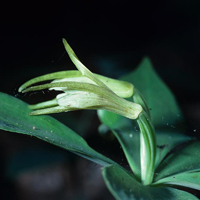Small whorled pogonia
Scientific name: Isotria medeoloides

Cover photo credit: Allen Woodliffe
Status
Endangered
“Endangered” means the species lives in the wild in Ontario but is facing imminent extinction or extirpation.
Read the Assessment Report
Date added to the Species at Risk in Ontario List
The Small whorled pogonia was already assessed as endangered when the Endangered Species Act took effect in 2008.
What it looks like
Small whorled pogonia is a small orchid that can reach 9.5 to 25 centimetres tall. At the end of the stem, it produces one to two yellowish-green flowers found just above a whorl of five to six leaves.
This plant generally flowers from mid-May to mid-June. The small fruits can hold thousands of tiny seeds. Without flowers, this species can resemble the more common Indian cucumber-root.
Where it lives
In Ontario, Small whorled pogonia is found in moist, mixed forests with acidic soils and a rich layer of decaying leaves.
It prefers openings in the forest where it can get lots of sunlight and where there are usually very few shrubs or other plants growing on the forest floor.
Where it’s been found in Ontario
In Canada, Small whorled pogonia is found only in the Calton Swamp area of Elgin County in southwest Ontario.
What threatens it
The greatest threat to Small whorled pogonia is habitat destruction. Collection by orchid enthusiasts and trampling by trail bikes and ATVs are also serious problems.
Pollution from factories and vehicles can harm Small whorled pogonia by killing the fungus in the soil that this plant depends on. Invasive plants that compete for space and light with this species are a potential threat.
Earthworms, which are not native to Canada, can ruin habitat by altering the fungus and leaf litter that this plant needs to grow.
Action we are taking
Endangered Species and their general habitat are automatically protected.
Recovery strategy
A recovery strategy advises the ministry on ways to ensure healthy numbers of the species return to Ontario.
Read the executive summary (February 18, 2011)
Read the recovery strategy (February 18, 2011)
Government response statement
A government response statement outlines the actions the government intends to take or support to help recover the species.
Read the government response statement (November 18, 2011)
Habitat protection
General Habitat Protection - June 30, 2008
What you can do
Report a sighting
- Report a sighting of an endangered animal or plant to the Natural Heritage Information Centre. Photographs with specific locations or mapping coordinates are always helpful.
Volunteer
Volunteer with your local nature club or provincial park to participate in surveys or stewardship work focused on species at risk.
Be a good steward
- private land owners have a very important role to play in species recovery; if you find Small whorled pogonia on your land, you may be eligible for stewardship programs that support the protection and recovery of species at risk and their habitats
- invasive species seriously threaten many of Ontario’s species at risk; to learn what you can do to help reduce the threat of invasive species, visit:
- the Carolinian forests of southern Ontario support an amazing diversity of plants and wildlife, including many species at risk; Carolinian Canada is working to help recover species at risk and their habitats; for more information, visit:
www.carolinian.org/SpeciesHabitats.htm.
Report illegal activity
Report any illegal activity related to plants and wildlife to
Quick facts
- the Small whorled pogonia appears to be primarily self-pollinated; the flowers lack nectar guides and fragrance and insect pollination has not been observed
- like all orchids, Small whorled pogonia obtains some nutrients from fungus in the soil
- orchids can remain underground for several years and will wait for the right conditions before starting to grow new plants